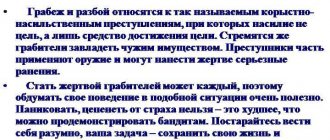Property crime
This is a category of crime, usually involving private property, that includes, among other crimes, burglary, theft, theft, auto theft, arson, shoplifting, and vandalism. Property crime is a crime committed to obtain money, property, or other benefit. This may include force or the threat of force in cases such as robbery or extortion. Since these crimes are committed for the purpose of enriching the offender, they are considered property crimes. Crimes against property are divided into two groups: destroyed property and stolen property. Destruction of property can be called arson or vandalism. Examples of the act of stealing property are robbery or embezzlement.
Property crimes are widespread crimes involving cash, electronics (such as televisions), power tools, cameras, and jewelry are often targeted.[1] "Hot products" are generally items that are hidden, removable, accessible, valuable, and enjoyable, with ease of "disposal" being the most important characteristic.[2]
Content
- 1 Types of property crimes 1.1 Arson
- 1.2 Burglary
- 1.3 Extortion
- 1.4 Theft 1.4.1 Bicycle theft
- 1.4.2 Embezzlement
- 1.4.3 Theft
- 1.4.4 Vehicle theft
- 1.4.5 Robbery
- 1.5.1 Mailbox baseball
- 2.1 Penalties for vandalism by minors 2.1.1 Restitution
- 4.1 Burglary
- 6.1 Visiting Forces Act 1952 6.1.1 England and Wales and Northern Ireland
Types of property crimes
Arson
Arson includes any intentional burning or attempted arson. Burning one's own property is also considered arson. A common motive for arson is insurance fraud, where the fire was started accidentally.[3] Other motives for arson include the desire to commit vandalism or harm, for thrill or excitement, for revenge, to cover up other crimes, or as a hate crime.[4] The Church Arson Prevention Act of 1996 was passed to protect places of worship.
Break-in
Burglary of residences, stores, and other commercial properties involves breaking and entering and theft of property. Attempting to forcefully enter property is also classified as burglary under the FBI's Uniform Crime Reports (UCR) definition.
As of 1999, there were 1.4 million residential burglaries in the United States, a record low number not seen since 1966.[5] However, up to 50% of burglaries are not reported to the police.[5] The clearance rate for burglaries is low: only 12.7% of cases were solved in the US in 2005,[6] and 23% in the UK.[5]
In the United States, burglary rates are highest in August and lowest in February, with rates affected by weather, length of day, and other factors.[5] Autumn and winter are peak seasons for burglary in Denmark.[7] Most burglaries occur on weekdays between 10-11 and 13:00, when the houses are least crowded.[5] The temporal pattern is reversed for non-residential burglaries, which are more likely to occur at night and on weekends when commercial premises are unattended.[8]
Burglary at residential construction sites is a growing problem in the United States, Canada, Australia, Europe and Japan, and elsewhere in the world, where theft of tools and equipment at residential construction sites accounts for 5 to 20 percent of construction costs.[9 ] In the United States, between $300 and $1 billion worth of equipment is stolen annually.[10] Large land developers suffer the most from this form of crime.[11]
Distracted burglary is a form of burglary where the offender(s) tricks or deceives the occupant or distracts the occupant, allowing an accomplice(s) to gain access and commit the burglary.[12] Older people are especially vulnerable to burglary.[12]
Little crime prevention programs such as Neighborhood Watch have shown little effectiveness in reducing burglaries and other crimes,[5] although can be effective when at least some community members are home on weekdays, thereby avoiding large gaps in surveillance by area during peak periods of residential property crime from 10:00 a.m. to 11:00 a.m. and from 1:00 p.m. to 3:00 p.m.[ citation needed
]
Extortion
Extortion is the use of threats to obtain another person's property. Some threats may include: future harm, destruction of property, damage to character or reputation, or death.
Theft
Cash is the most stolen, followed by car parts, clothing and tools.[2]
In 2005, only 18% of reported theft/theft cases were cleared in the United States.[6]
Theft is a special type of theft of goods taken from retail stores without payment. Items popular with thieves include: cigarettes, alcoholic beverages, and fashionable clothing.[2]
Bicycle theft
Bicycle theft is a crime involving the theft of a bicycle. Those who want to steal bikes can use many different methods to do so.
- Lifting: If the bike is attached to an unsafe structure, such as a small sign or tree, a thief may be able to lift the bike and lock off the structure.
- Cutting: A thief can use a bolt cutter, hacksaw or angle grinder to cut through the bike lock.
- Picking: A thief can pick a keyhole that requires a keyhole.
Embezzlement
Theft is the misappropriation of property by a person to whom it was entrusted. For example, if the named person trusts his friend enough to allow him to keep his wallet, and the friend goes home without returning the wallet with the intention of keeping the money, the friend might commit embezzlement.
Theft
Theft is the unlawful taking of someone else's property with the intent to deprive it of its owner. If the value of the stolen item exceeds a large amount, it is considered a felony and is called grand theft. Petty theft is theft and an item of little value and is treated as a misdemeanor. If a person has a lost item and there is a reasonable way to find the owner, he must return it, otherwise it will be considered theft. For example, if someone finds a wallet with an ID in it, it is their duty to find a way to return it to its owner. Shoplifting and attempted shoplifting fall under this category.
Vehicle theft
Vehicle theft is a common form of property crime, often committed by young people for fun. The FBI includes attempted motor vehicle thefts in its definition of Uniform Crime Report (UCR). About 15-20% of vehicle thefts are carried out for their auto parts or with the intent to resell them on the black market.[13] Crime prevention and targeted measures such as car alarms and ignition switches have been effective means of preventing vehicle theft, as have techniques such as etching VIN number on auto parts.[13]
In 2005, only 13% of reported vehicle theft cases in the United States were solved.[6]
Some types of cars are more popular with thieves, with sports cars often preferred by car thieves for a fun ride.[2] SUVs also have a higher theft rate, with the Cadillac Escalade cited in 2003 by the Highway Data Loss Institute as the most common theft complaint. in the USA.[14]
Construction machines are also often stolen because they can be easily resold on the used market.[2]
Robbery
Robbery is the unlawful taking of property from a person's immediate possession using force of intimidation.
Vandalism
Vandalism is the deliberate destruction or damage of a person's property. Millions of injuries occur every year. Some examples are: breaking windows, destroying mailboxes, throwing eggs, graffiti, etc.
Baseball mailbox
A mailbox (left) damaged during a baseball game.
Mailbox baseball or mailboxing is an activity in which a baseball bat or other object is used to knock over, dent, or break roadside mailboxes by a passenger in a car. It can be played as a game, with scores kept in a similar manner to baseball, or played simply for aimless fun. In any case, this is an act of vandalism and destruction of someone else's property.
Mailbox baseball is depicted in several films and television shows such as Stand By Me
,
Benches
,
Dazed and Confused
,
Freaks and Geeks
,
21 Jump Street
,
CSI: Crime Scene Investigation
(Season 9, Episode 7; "Woulda, Coulda, Shoulda"),
Phantom Whisperer
,
The Simpsons
,
The Family Man
, and
The X-Files
.
Damaging, destroying, or tampering with mailboxes or U.S. mail is a federal crime, punishable by a fine and/or up to three years in prison.[15]
Object and subject of crimes against property
In criminal law science, questions about the object of theft and other selfish crimes against property still remain controversial. Most researchers believe that the direct object coincides with the specific object. The legislation of the Russian Federation provides for equal protection of different forms of property. To assess the act as a criminal act, the subject of ownership does not matter.
Finished works on a similar topic
Course work General characteristics and types of crimes against property 440 ₽ Abstract General characteristics and types of crimes against property 220 ₽ Test work General characteristics and types of crimes against property 240 ₽
Receive completed work or specialist advice on your educational project Find out the cost
Various researchers consider the object of theft as:
- economic category;
- ownership;
- property interest;
- property.
The object of a crime against property is a legal and economic category. Since the property relations existing in society are actually fixed and protected by norms regulating relations between subjects related to issues of ownership, disposal and use of property, when a criminal act against property is committed, they can be violated in the same way as the relations by which they are regulated.
Property is a specific object of crimes under the Criminal Code (Chapter 21). The generic object is the relationship that ensures the normal functioning of the state’s economy. Some authors believe that social relations regulating the economic sphere must be considered as a complex object that forms 2 or more generic objects (including property).
The Criminal Code includes property as the subject of crimes. Fraud has the right to property, extortion - other actions of a property nature. Property (as the subject of a crime) is an object (thing) of the material world that has a certain value and in relation to which property relations exist.
Signs of property:
- The physical sign of property is objects of the external world, accessible to objective perception, defined in space, having volume, mass, density.
- The economic sign indicates that property (as an item of property) can be any thing that has value, which is expressed in value. Securities (checks, bills, bonds, savings books, savings certificates, shares, etc.), money have economic value.
- Legal sign. The subject of a crime can only be someone else's property that is in legal possession or ownership.
Note 2
The subject of the crime can be real and movable property. Real estate refers to the subject of misappropriation or embezzlement, fraud, damage, destruction of property, extortion.
Law
Criminal law is intended to maintain social order and protect the authority of the state. In a capitalist society, criminal law is also important for the protection of personal property and the creation of a favorable environment for economic activities.
In 1473, the Case of the Carrier
in England to set a precedent for criminal law in establishing the right to protect private property. An English court ruled against those who transported goods on behalf of others and illegally stored those goods, saying they constituted the crime of theft. The Court recognized the importance of protecting property rights in creating an environment for the English language. trading system to flourish.[16][17]
In the United States, burglary is considered a felony, and the Federal Bureau of Investigation counts burglary, larceny, motor vehicle theft, and arson in its Uniform Crime Reports statistics.[18]
Penalties for vandalism by minors
Restitution
Pay for damage during repair or replacement. The judge may order the offender to find or maintain employment.
Fines
The money paid to the court can range from hundreds to thousands.
Probation
Must perform certain tasks (study, work, visiting a psychologist, etc.).
Abstraction
Similar to probation.
Detention
This may be full time, weekends, or increased supervision.
Property crime lawyer
The main role of a lawyer in cases of crimes against property is to establish the presence or absence of certain qualifying features in a crime, which can significantly influence the type and amount of punishment imposed by the court on the guilty person. An experienced lawyer for property (selfish) crimes will be able to understand all the intricacies of a criminal case under the articles of Chapter 21 of the Criminal Code of the Russian Federation.
The work of law enforcement agencies is aimed at investigating cases in a short time, so often many facts and details that could prove the suspect’s innocence are not taken into account. In addition, the suspect may be subjected to psychological pressure or illegal measures used to admit guilt. The actions of a lawyer for crimes against property will be aimed at including all the facts in the case file and at suppressing illegal methods of investigation.
Trends
Property crime rates in the United States, 1986-2005.
(Source: FBI. UCR data, which shows only reported crimes) In 2004, 12% of households in the United States committed some kind of property crime, the most common of which was theft.[19] The percentage of U.S. households experiencing property crime fell from 21% in 1994 to 12% in 2004.[19] In Finland, there was also a noticeable decrease in the number of teenagers committing property crimes from 1995 to 2004.[20]
The United Kingdom has similarly seen a significant decline in property crime, with car thefts and house burglaries falling by 24%, and burglaries, car thefts and other thefts falling by 45% from 1995 to 2004.[21] From 2001 to 2004 New South Wales in Australia has seen a significant decline in property crime, with vehicle thefts down by 39%, among other downward trends in property crime.[22]
From 1996 to 2005, the number of arrests in the United States for property crimes decreased by 22.1%. The decline is much larger for offenders under the age of 18, with arrests for property crimes down 43.8%, compared to a 9.5% decrease for those 18 and older.[23] The peak age for property crime arrests in the United States is 16, compared to 18 for those arrested for violent crimes.[24]
General characteristics of crimes against property
Note 1
Crimes against property are unlawful intentional or careless socially dangerous acts provided for by the Criminal Code (Chapter 21, Articles 158-168), encroaching on someone else’s property and/or causing material damage to the owner.
Property relations are the most important component of the activities of any citizen and individual, state and society. Criminal legislation attaches great importance to the protection of property. Particularly important are issues related to crimes against property, which is due to the increasing frequency of such crimes, the significant volume of property losses, and, as a consequence, the frequency of application of legal norms providing for liability for crimes of this category.
Are you an expert in this subject area? We invite you to become the author of the Directory Working Conditions
Problems related to ensuring the inviolability of property, legal rights and interests of citizens are largely aggravated by social tension and the impoverishment of a significant part of the population.
The social danger of this group of crimes is due to the fact that they violate the relationship of belonging of a certain thing to the owner, who loses possession of the thing and therefore suffers property (material) damage and is deprived of the opportunity to extract useful properties from the thing. The owner loses the opportunity to resolve issues regarding the functioning of the property owned by him.
Crimes against property damage the subjective right of property - the legal content of property relations. Criminal acts violate this right, which provides the subject with general legal power over the property owned. The owner cannot practically exercise powers in relation to property that has ceased to be in possession.
Theory
Break-in
Situational factors or characteristics of a building's environment may make it a more attractive target for intruders.[25] Property owners can change situational factors to make the property less attractive to potential offenders. According to rational choice theory, criminals weigh costs/risks and benefits when deciding whether to take advantage of an opportunity to commit a crime.[26]
Another factor is the permeability of residential areas or accessibility to external transport. The proximity of residential areas to major highways is also an important factor, as such roads tend to be the most familiar to criminals and the public in general. Criminals try not to stray too far from familiar places.[27]
Robbers who take money and jewelry typically travel on foot, choosing targets close to busy city centers, while robbers who target electronics often travel by car, preferring targets in suburban areas.[28]
United Kingdom
Visiting Forces Act of 1952
The expression "offense against property" is used as a term in section 3 of the Visiting Forces Act 1952 (15 and 16 Geo.6 and 1 Eliz.2 c.67) and is defined for that purpose by paragraphs (England and Wales and Northern Ireland) and (Scotland) Schedules to this Act
England and Wales and Northern Ireland
In applying section 3 of the 1952 Act to England and Wales and Northern Ireland, this means any offense punishable under any of the following legislation:
- The Malicious Damage Act 1861
- section 13 Debtors Act 1869 and section 13 Debtors (Ireland) Act 1872 (which relate to obtaining credit under false pretenses and certain creditor frauds)
- section 28 Road Traffic Act 1930 and section 4 Vehicle and Traffic (Northern Ireland) Act 1930 (which relate to the removal of a vehicle without the owner's consent)[ Why?
] - then Theft Act 1968 except section 8 (robbery)
- then Theft (Northern Ireland) Act 1969 except section 8 (robbery)
- the Theft Act 1978
- The Theft (Northern Ireland) Order 1978
- the Damages Act 1971
- the Criminal Damages Order 1977 (Northern Ireland)
- then the Fraud Act 2006[30]
- an offense under section 2 of the Explosives Act 1883 of an explosion likely to cause serious property damage in connection with such an attack as specified in section 1(1)(b) of the Internationally Protected Persons Act 1978.
- an offense under section 2 of the Nuclear Materials (Crimes) Act 1983 if the circumstances are such that, either in the case of a contravention of subsection (2), the act falling within paragraph (a) or (b) of that subsection would have occurred had it been committed, would constitute an offense falling within the above subsections, or, in the case of a violation of subsections (3) or (4), the threatened act would, if committed, constitute such an offense
- an offense under section 2 of the Explosives Act 1883 of an explosion likely to cause serious damage to property in connection with such an attack as specified in section 2(1) of the United Nations Personnel Act 1997
Scotland
In applying section 3 of the 1952 Act to Scotland, this means any of the following offences:
- theft, breaking and entering with intent to steal, unlocking with intent to steal, factory reset, plagiarism, breach of trust and embezzlement, lying, fraud and fraudulent imposition, threats to extort money or with intent to extort money, and malicious mischief
- any offense under section 28 of the Road Traffic Act 1930
- any of the following offenses in connection with such an attack as mentioned in section 1(1)(b) of the Internationally Protected Persons Act 1978: the offense of intentionally starting a fire
- offense under section 2 of the Explosives Act 1883 of an explosion likely to cause serious damage to property
- crime of intentionally setting fire
Classification of crimes against property
The issue of classification of crimes against property is debatable. Of course, there are classifications that do not cause controversy. Thus, depending on the form of guilt, intentional and careless attacks on property are distinguished. Following the criminal law, the vast majority of offenses are classified as intentional (Articles 158-167 of the Criminal Code of the Russian Federation); to the careless - only the crime provided for in Art. 168 of the Criminal Code of the Russian Federation. A.G. Bezverkhov proposed a classification of property crimes according to the nature and degree of public danger of the encroachment: crimes of minor gravity, moderate gravity, grave and especially grave.
It is traditional to classify crimes against property into groups depending on their motivational orientation. There are mercenary and non-mercenary attacks. So, A.I. Rarog believes that mercenary crimes are divided into two groups: theft (Articles 158-162, 164 of the Criminal Code of the Russian Federation) and other mercenary crimes (Articles 163, 165, 166 of the Criminal Code of the Russian Federation). Unselfish attacks, in his opinion, include Art. 167 and 168 of the Criminal Code of the Russian Federation. Almost the same position is held by Z.A. Neznamov and I.G. Solomonenko, who call a group of other mercenary crimes crimes not related to theft. The position of I.Ya. is also close to this. Kozachenko, stipulating the presence of:
- selfish attacks on property in the presence of signs of theft;
- encroachments on property in the absence of signs of theft;
- other encroachments on property.
However, by what criterion the third category of encroachments on property is distinguished remains unclear, although it can be assumed that we are talking about non-mercenary encroachments.
A.N. Ignatov, also adhering to the division of crimes against property into selfish and non-selfish, divided selfish crimes into violent (robbery, robbery) and non-violent (all others). The same division is made by G.N. Borzenkov (his classification of encroachments on property is discussed below), including among the divided crimes also extortion, which is classified as a violent crime.
S.A. Eliseev, without using the terms “selfish” and “non-selfish” attacks, singles out:
- crimes that entail a decrease in the scope of property possession of the victim, but are not accompanied by a corresponding increase in the possession of the perpetrator (deliberate and careless destruction of property);
- crimes entailing a decrease in the scope of property possession of the victim, accompanied by a corresponding increase in the possession of the perpetrator (all other crimes).
Recently, new classifications of crimes against property have appeared in criminal law science. So, A.G. Bezverkhov proposed a classification based on two criteria:
- ownership of property (in the form of things) to subjects of property rights or other owners;
- transfer of property (in the broad sense) from one participant in the specified relationship to another.
Guided by the above criteria, A.G. Bezverkhov says:
- about encroachments that are expressed in unlawful seizure and other unlawful taking of someone else’s property or destruction and damage to someone else’s property (theft, robbery, robbery, hijacking, intentional and careless destruction and damage to property);
- offenses consisting of unlawful evasion by the perpetrator of obligations to transfer property (from paying what is due) or unlawfully inducing the victim to transfer property or commit another action of a property nature (embezzlement, embezzlement, fraud and other damage by deception or using trust, extortion ).
Absence from the list of Art. 164 of the Criminal Code of the Russian Federation, the author explains that this crime “may be considered unnecessary due to the real possibility of ensuring counteraction to this encroachment by such means of criminal law as prohibitions on theft of other people’s property (Articles 158-162).”
N.G. Ivanov, taking into account the peculiarities of the objective side of acts, divides all crimes against property into theft and crimes that are not theft.
A.I. Depending on the subject of the attack, fighters are distinguished:
- crimes the subject of which are objects of property law, including money and securities (theft, fraud, misappropriation, embezzlement, robbery, robbery, theft of items of special value, intentional and careless destruction or damage to property);
- crimes, the subject of which may be any (in the broad sense of the word) property, including property rights, as well as other objects of civil rights, including works and services, information, results of intellectual activity, including exclusive rights to them (extortion, causing property damage by deception or breach of trust, theft).
According to A.V. Brilliantov and I.A. Klepitsky, in the system of property crimes (as they call crimes against property), depending on the type of these relations, one can distinguish:
- crimes against property in the narrow sense of the word (theft, robbery, robbery, misappropriation and embezzlement, theft, destruction and damage to property);
- crimes against property in general (fraud, extortion, causing property damage by deception or breach of trust).
However, more often in science all crimes against property are classified into three groups, usually without indicating the criterion used. So, they distinguish:
- theft (Articles 158-162, 164 of the Criminal Code of the Russian Federation);
- causing property or other damage not related to theft (Articles 163, 165, 166 of the Criminal Code of the Russian Federation);
- destruction or damage to property (Articles 167, 168 of the Criminal Code of the Russian Federation).
L.D. Gauchman says:
- about theft;
- about other types of unlawful taking or use of someone else’s property (Articles 163, 165, 166 of the Criminal Code of the Russian Federation);
- about destruction or damage to property.
Yu.I. Lyapunov called the second group of crimes crimes that cause (or may cause) property damage to property relations. V.P. Revin distinguishes theft (Articles 158-162, 164 of the Criminal Code of the Russian Federation), other mercenary attacks (Articles 163, 165, 166 of the Criminal Code of the Russian Federation) and non-mercenary attacks (Articles 167, 168 of the Criminal Code of the Russian Federation).
E.S. Tenchov believes that there are three sub-institutions of crimes against property:
- thefts encroaching on the entire set of property relations in the production or consumer and at the same time in the distribution spheres (Articles 158-162, 164 of the Criminal Code of the Russian Federation);
- crimes that are not theft, aimed at extracting property benefits (Articles 163, 165 of the Criminal Code of the Russian Federation), and encroaching on property in the distribution sector;
- criminal acts devoid of such an orientation, encroaching on property in the production or consumer spheres (Articles 166-168 of the Criminal Code of the Russian Federation).
A unique classification is proposed by G.N. Borzenkov:
- Acquisitive crimes related to the unlawful extraction of property benefits: theft of other people's property;
- crime related to theft: extortion (Article 163 of the Criminal Code of the Russian Federation);
- other mercenary crimes: causing property damage by deception or abuse of trust (Article 165 of the Criminal Code of the Russian Federation); unlawful taking of a car or other vehicle without the purpose of theft (Article 166 of the Criminal Code).
Without dwelling specifically on the disadvantages and advantages of the above classifications (for traditional classifications this has already been done more than once, see, for example, the works of S.M. Kochoi; as for the classification of A.G. Bezverkhov, it requires further understanding, although it immediately raises doubts about the possibility of scientific classification simultaneously according to several criteria), I note that the most correct and convincing classification of crimes against property, proposed at one time by S.M. Kochoi (now she has transformed, see below). He highlighted:
- Acquisitive crimes against property: theft (Articles 158-161, 164 of the Criminal Code of the Russian Federation);
- acquisitive crimes against property that do not contain signs of theft (Articles 162, 163, 165 of the Criminal Code of the Russian Federation).
- theft (Article 166 of the Criminal Code of the Russian Federation);
It is noteworthy that, dividing mercenary attacks into theft and crimes that do not contain signs of theft, S.M. Kochoi attributed robbery to the second subgroup. I think the author is absolutely right.
The modern legislative structure of robbery is in deep contradiction with the legislative definition of theft. An attack for the purpose of stealing someone else's property, combined with a certain physical or mental impact on the victim, is not equivalent to theft. Moreover, theft generally remains outside the scope of robbery. Therefore, there is no reason to consider robbery a form of theft. For this it would be necessary, as S.M. wrote. Kochoi, change the criminal law, formulating the composition of robbery as material. Until this happens, from the point of view of the purity of qualifications, it would be necessary to subject the fact of theft in the robbery to an independent assessment.
In this regard, a paradoxical situation is emerging in science. It is impossible not to notice that robbery has little in common with theft. However, from the interpretation of the letter of the law (in the note to Article 158 of the Criminal Code of the Russian Federation, for example, it speaks of theft and extortion and indicates Articles 158-164 of the Criminal Code of the Russian Federation) it follows that robbery is theft. And science is put in a situation where it has to explain this contradiction in order to “save the face” of the legislator. So, A.I. Rarog writes: “...The special structure of robbery, recognized as one of the forms of theft, forces us to make a reservation: robbery is a special form of theft, not associated with a violation of the right of ownership, but only pursuing the goal of stealing someone else’s property.” Perhaps the change in position of S.M. is connected precisely with the noted legislative awkwardness. Kochoi regarding robbery. In his latest work - the author's textbook - he already classifies robbery as theft, although I am sorry that he switched to this position.
S.M. is right Kochoi and in classifying theft as non-mercenary encroachment on property, contrary to the opposite and more widespread point of view in the literature. M.I. also consider hijacking a non-mercenary crime. Tretyak and R.Z. Abdulgaziev. Self-interest is not only a mandatory, but even a frequently occurring feature of this crime, although it undoubtedly violates the individual powers of the owner or legal possessor. A.V. Brilliantov and I.A. Klepitsky explains the mercenary nature of the theft this way: “The thief realizes that he is illegally temporarily using someone else’s thing, and this is a property benefit (renting a car costs money).” However, self-interest in encroachments on property, and in the Code in general, is mainly understood not as the extraction of benefits, but as the acquisition of something that did not exist.
Recommendations
- Freiberg, Arie (December 1996). “The Property Crime Market: A Regulatory Approach” (PDF). Burglary and car theft: is your property safe?, Melbourne, Australia.
- ^ a b c d e
Clark, Ronald W. (1999).
"Hot Products: Understanding, Predicting, and Reducing Demand for Stolen Goods" (PDF). Police Research Series, Paper 112
. Ministry of the Interior, Policing and Crime Reduction Unit. Archived from the original (PDF) on 2006-11-14. Retrieved 2006-11-10. - Douglas, John E., Allen G. Burgess, Robert K. Ressler (2006). Guide to Crime Classification
. Wiley. pp. 41–42.CS1 maint: several names: list of authors (link to site) - Douglas, John E., Allen G. Burgess, Robert K. Ressler (2006). Guide to Crime Classification
. Wiley. pp. 261–287.CS1 maint: several names: list of authors (link to site) - ^ a b c d f f
Weisel, Deborah Lamm (July 2002). "Burglaries in Single-Family Homes" (PDF). COPS. Archived from the original (PDF) on May 13, 2015. - ^ a b c
"Dispatches - Crime in the United States, 2005." FBI. Archived from the original on 2006-11-01. Retrieved 2006-11-03. - Sorensen, D. (2004). "Temporal Patterns of Danish Residential Burglary." Justice Ministry. Archived from the original on 2006-10-08. Retrieved 2006-11-03.
- Ratcliffe, Jerry H. (2001). "Police Burglary in the City" (PDF). Trends and Issues in Crime and Criminal Justice, No. 213
. Australian Institute of Criminology. - Boba, Rachel (August 2006). “Burglaries on Construction Sites of Single-Family Homes” (PDF). COPS.
- “Law enforcement is paying attention to thefts at construction sites.” Construction Equipment Manual. March 2, 2005
- "Construction frenzy causes rise in home website thefts." FOX11AZ.com. February 6, 2005. Archived from the original on September 27, 2007. Retrieved November 10, 2006.
- ^ a b
"Burglary Diversion". Home Office. Archived from the original on 2006-11-12. Retrieved 2006-11-03. - ^ a b
Sutton, Adam (December 1996). "Property Crime Prevention: The Future" (PDF). Burglary and car theft: is your property safe?, Melbourne, Australia. - “The Cadillac Escalade SUV is a prime target for theft and has the worst overall theft loss coverage” (PDF). Road Data Loss Institute. August 21, 2001
- "18 USC § 1705 - Destruction of mailboxes or mail." Cornell University School of Law. Retrieved May 23, 2009.
- Siegel, Larry J. (2003). "Chapter 2". Criminology
. Wadsworth. - Hall, Jerome (1952). Theft, Law and Society
(2nd ed.). - "Crime against property." Crime in the USA
. Federal Bureau of Investigation. 2004. Archived from the original on 2008-07-09. Retrieved 2008-11-10. - ^ a b
Klaus, Patsy (April 2006). “National Crime Victimization Survey—Crime and National Households, 2004.” (PDF). Bureau of Justice Statistics. Archived from the original (PDF) on September 27, 2006. - Kivivuori, Janne, Venla Salmi. "Trends in self-reported juvenile delinquency in Finland, 1995-2004." (PDF). Archived from the original (PDF) on 2008-04-11. Received 2006-11-10.CS1 maint: several names: list of authors (link to site)
- "Crime in England and Wales 2004/2005" (PDF). Home Office. July 2005. Archived from the original (PDF) on 2006-08-11. Retrieved 2006-11-10.
- Vancouver, British Columbia, Canada has the highest rate of property crime in North America. Moffatt, Steve, Suzanne Poynton (January 2006). "Long-term trends in property and violent crime in New South Wales: 1990–2004" (PDF). New South Wales Bureau of Crime Statistics and Research.CS1 maint: several names: list of authors (link to site)
- "Table 32 - Crime in the United States, 2005." Federal Bureau of Investigation.
- FBI Uniform Crime Reports, 2000
- Brantingham, P.J. and P.L. Brantingham (1981). Environmental Criminology
. Sage Publications. - Bennett, T., R. Wright (1986). Burglars about burglary
. Gower.CS1 maint: several names: list of authors (link to site) - White, Garland F. (1990). “Neighborhood permeability and burglary rates.” Justice Quarterly
.
7
(1):57–67. Doi:10.1080/07418829000090471. - Poyner, B., B. Webb (1991). Crime-free housing
. Butterworth.CS1 maint: several names: list of authors (link to site) - Weatherburn, Don, Peter Graboski (March 1997). "Strategic Approaches to Combating Property Crime" (PDF). Second National Perspectives Symposium: Violent Crime, Property Crime and Public Policy, Canberra, Australia.CS1 maint: multiple names: list of authors (site link)
- Item 3(m) added by Fraud Act 2006, Schedule 1, paragraph 2








